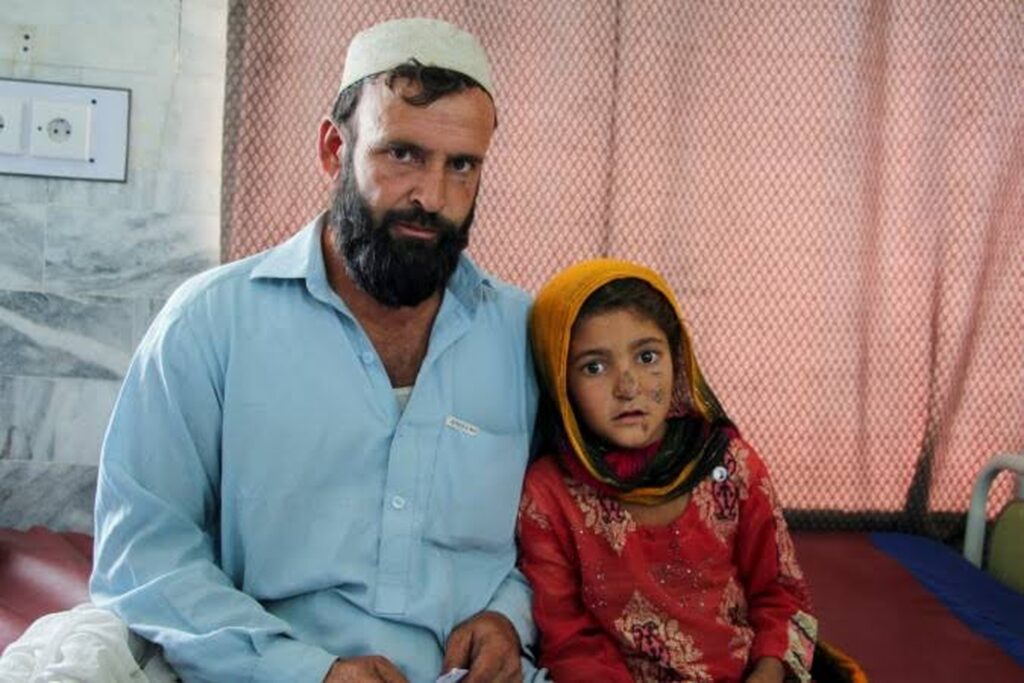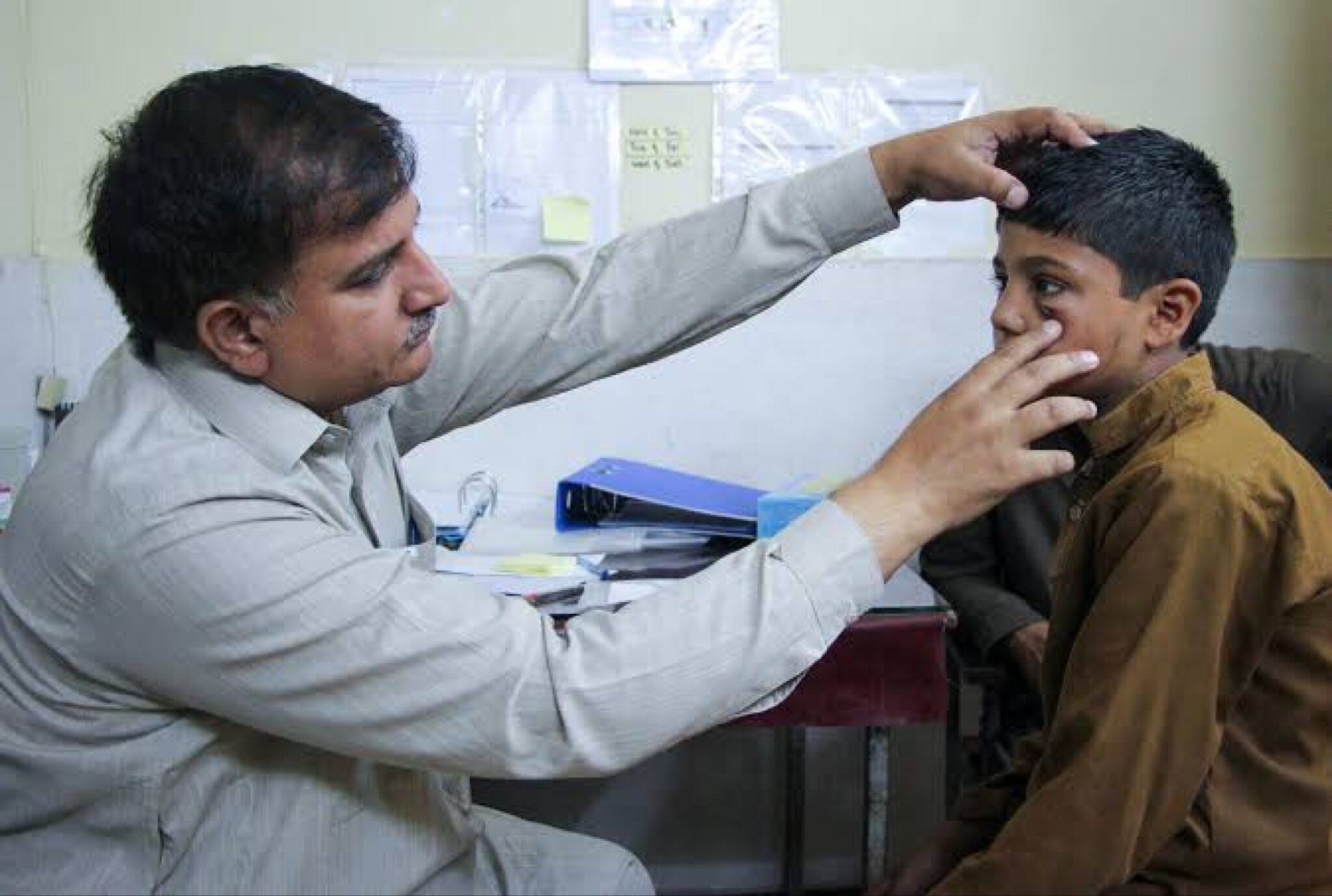The rash on his daughter’s face had turned into a large lesion, sore and extremely itchy. Gul Bibi was also running a high fever, and Abdul Wali was worried. The only skin doctor in Zhob district, north west Balochistan, diagnosed her with leishmaniasis, more commonly called “kal-dana” locally.
But in fact there’s little awareness of leishmaniasis in rural parts of Balochistan. “When Gul Bibi complained of rash and pain on her cheek, we thought it was a common sore, as skin diseases were widespread in our area after the historic flooding,” said Abdul Wali. But weeks passed, the itching grew worse, and the fever set in.
After her diagnosis, Wali brought his daughter to Benazir Shaheed Hospital Quetta due to the severe dearth of medicine and treatment facilities in remote Zhob.
He said the doctor in Quetta prescribed a course of injections labelled “Glucantime” – the commercial name for Meglumine antimoniate, the first-choice drug against all forms of leishmaniasis.
The cost for the treatment would run to more than 20,000 Pakistani rupees (USD 74), Wali said.
“I somehow managed expenses, but hospital authorities later informed me that they had run out of Glucantime stock. The injection wasn’t available in the open market either,” Wali recalled.

Sandfly scourge
A parasitic infection spread by the sandfly, cutaneous leishmaniasis is spreading fast in Balochistan, with the Federal Ministry of Health reporting a spike in cases in the province in the first quarter of 2022. The majority of people affected were women and children.
Cutaneous leishmaniasis (CL) is one of three forms of the disease. Unlike visceral leishmaniasis, also called “kala-azar”, the cutaneous form is not typically fatal – but can be scarring and disabling.
In CL, the site of the sandfly bite soon develops a papule or nodule, which may eventually develop into large plaques or ulcerating lesions, depending on the particular species of the parasite, and the host’s immune response.
According to Dr Zeeshan Haider, Associate Professor of Microbiology and Biomedical Sciences at the University of Lahore, these lesions may be self-healing. However, this can take several months to years – with a typical recovery time of two to eight months. Left untreated, these so-called “Oriental sores” can develop into chronic disfiguring lesions or swelling of the affected parts, inhibiting mobility.
According to Dr. Zeeshan Haider, these lesions may be self-healing; however, this can take several months to years, depending on the species. Leishmaniasis major lesions usually heal within two to eight months. If left untreated, they can develop into chronic disfiguring lesions or swelling of the affected parts, further causing disability and disfigurement.
The sandflies mainly bite on exposed body parts, like the face, legs, feet, and hands. More often than not, these lesions leave scars leading to psycho-social problems, stigmatisation, and discrimination in families and communities, especially for women, said Dr. Zeeshan.
A growing problem
According to WHO data, 186,703 leishmaniasis cases were reported across Pakistan between 2014 and 2018. Balochistan province, where more than 60,000 cases were reported in that time period, appeared to be the epicentre already at the time.
Balochistan registered 21,000 in the 12 months between January 2021 and 2022, showing an accelerating spread of the disease. That uptick was concentrated in rural areas.
Dr Mubashir Khan, a specialist at Children’s Hospital Quetta, said that a major factor behind the recent increase in leishmaniasis cases in both Sindh and Balochistan provinces has been migration from Afghanistan, with most cases reported in the border lands.
Other significant factors are climate change, urbanisation, poor hygiene, and sanitation conditions in rural areas. Sandflies thrive among mud and unplastered houses, especially where livestock are abundant.
A deadly relation
That’s a potentially deadly concern. Sandflies also spread CL’s more dangerous cousin, visceral leishmaniasis, which, if untreated, is fatal in almost every case. WHO estimates 50,000-90,000 new cases of VL a year, concentrated in Brazil, east Africa and India.
Dr Shahzeen Saifullah, a skin disease expert in Karachi who handled what may have been the first reported case of successfully-treated visceral leishmaniasis from Gilgit Baltistan, told VaccinesWork just how grave VL can be – even handled in a hospital setting.
A sick five-year-old child from the city of Swat was brought to him at the Civil Hospital Karachi. According to Dr Saifullah, the boy suffered from high grade fever and had several lesions on his nose and face. The boy was weak, suffered chills and rigors, his abdomen distended. He bled from his rectum. It took five weeks of in-patient treatment before the child stabilised, found his appetite again, and began to slowly return to health.
The disease, Dr Saifullah suggests, is very often missed or misdiagnosed.
Prevention and cure
Abdul Wali is not the only worried parent to find himself with a clinical diagnosis for his daughter’s illness, but without reliable access to treatment.
Low stocks of effective medicines at regional health centres mean that thousands of CL patients from rural areas make the journey to the Medicins Sans Frontiers (MSF) leishmaniasis centres at Quetta and Kuchlak in Balochistan, and Peshawar in Khyber Pakhtunkhwa.
According to Dr. Zeeshan Haider, Glucantime is an effective drug for treating cutaneous leishmaniasis in central Iran. In fact, cutaneous leishmaniasis heals spontaneously, and to prevent the acquisition of resistance, the indications for treatment in each region should be defined carefully.
The Drug Regulatory Authority Pakistan (DRAP) has issued an alert that certain agencies or pharmacies used to sell non-regulated/ false medicine (Glucantime) with the same name in Quetta and the rest of Pakistan.
The leading company claimed to be manufacturing this has confirmed that they do not manufacture this product and neither they sub-contract the manufacturing, nor distribute these products anywhere in the world, said Dr. Zeeshan.
According to Shahzad Badar, field communication officer at MSF Pakistan, MSF has been treating leishmaniasis at Kuchlak in Balochistan since 2008.
“In Balochistan, three well-established cutaneous leishmaniasis centres are providing free treatment,” Badar said. “In 2022, nearly 5,974 patients received treatment from [Khyber Pakhtunkhwa] and Balochistan clinics.”
Badar explained that prevention and control of the sandflies requires effective integrated vector control management, which is highly complex. “Therefore, our primary focus is on early diagnosis and effective treatment to reduce the prevalence and, thus, the transmission.”
MSF is training up local corps of lady health workers (LHWs) to spot and spread awareness of this growing public health problem. These lady health workers visit villages to make people aware of the severity of the disease and explain preventative measures. Those include the use of chemically-treated bed nets, sealing cracks in houses, placing traps in windows, regularly removing garbage and spraying insecticides.
“We are arranging training sessions for Ministry of Health paramedics for the diagnosis and cutaneous leishmaniasis case management. To increase access to prompt diagnosis and effective treatment, we will enhance this programme to Bannu and other areas of KPK in the coming months,” added Badar. Like Balochistan’s, Khyber Pakhtunkhwa’s CL caseload has been mounting since 2018.
New strategies for the treatment
According to Dr. Zeeshan Haider, unfortunately, no vaccine against is currently available worldwide against Leishmaniasis for humans. But certain vaccines are at hand for Leishmaniosis in Dogs.
A couple of scientists are working on developing new technologies, therapies, or drug regimes. Like Nanotechnology, the use of Nanoparticles against these resistant Leishmania strains. But this is at a very nascent stage and currently invitro studies are going on, and it may have side effects.
- Moreover, MSF has started a clinical trial in which we are studying the effectiveness of three other modes of treatment. According to Shahzad Badar, these treatments are:
- An oral drug, miltefosine, which patients can take at home.
- Thermotherapy, the heat delivered on the site of the CL lesions via radio frequency. It is a procedure that only requires one session.
- The combination of these treatment modalities with a shorter course of miltefosine.
A few parts of this story have earlier been published at Gavi, The Vaccine AllainceAlliance. We republished it with the author’s permission.
Also, read: Cardiovascular diseases are the number one cause of deaths worldwide

Saadeqa Khan is the founder, CEO, & Editor-in-Chief of Scientia Pakistan. She’s a member of the Oxford Climate Journalism Network (Second Cohort) and NASW. Saadeqa is a fellow of NPF Washington, The Falling Walls Foundation, and the Science Journalism Forum. Saadeqa has won several international journalism grants and awards for her reports.

